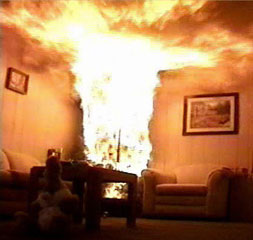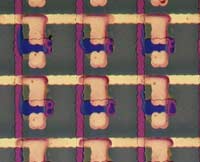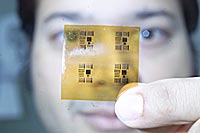Greeting
Another New Year Without a Leap Second
Does
it seem like the world is speeding up? That the pace of life
is increasing?
If you
feel that way, there’s scientific evidence to prove your
point. The world has sped up over the last few years. Timekeepers
at the National Institute of Standards and Technology (NIST)
note that they have not had to insert an extra second (called
a leap second) into their time scale for five years. Why? Because
the rate of the Earth’s rotation has sped up since 1999.
From 1972
(when the world went to the current system of atomic timekeeping)
until 1999, 22 seconds were added to the world’s time
in order to keep atomic time synchronized with Earth’s
time, as measured by the Earth’s spin. Since then, none,
nada. Scientists are not sure why this is so, but they do offer
some thoughts.
Tom O’Brian,
a physicist and chief of NIST’s Time and Frequency Division
in Boulder, Colo., suggests changes in motion of the Earth’s
core, the effect of ocean tides and weather, and changes in
the shape of the Earth may all be affecting the spin of Mother
Earth. In general, he notes, the long-term trend has been for
the Earth’s rotation to slow down, but not in the last
five years.
O’Brian
said most scientists expect the Earth to continue slowing down
again in the future. So maybe there is hope for those feeling
particularly harried.
“The
Earth’s rotation rate has been the primary clock for nearly
all of human history,” he says, adding that “only
in the last 50 years have we had clocks accurate enough to measure
changes in the Earth’s spin.” NIST introduced the
world’s first atomic clock in 1949.
For more
information about leap seconds, see http://tf.nist.gov/general/leaps.htm.
Media
Contact:
Fred McGehan,
(303) 497-3246


Experts
Stress Importance Of Holiday Fire Safety
 |
| NIST
fire test demonstrates how quickly a flame can ignite
a
dry holiday tree. |
Every
year approximately 400 residential holiday tree blazes
kill
10 people, injure 80 and cause more than $15 million in property
damage. Typically, shorts in electrical lights or open
flames
from candles, lighters or matches start tree fires. Fire protection
engineers at the National Institute of Standards and Technology
(NIST) stress the importance of keeping trees watered.
A video clip on the NIST Web site, www.fire.nist.gov/tree_fire.htm,
illustrates how quickly fire can develop when a dry
tree is exposed to an open flame. Within three seconds of ignition,
the scotch pine is completely ablaze. At five seconds, the fire
extends up the tree and black smoke with searing gases streaks
across the ceiling. Fresh air near the floor feeds the fire.
The sofa, coffee table and the carpet ignite prior to any flame
contact. Within 40 seconds “flashover” occurs—
that’s when flames completely engulf the room, depleting
the oxygen and turning the atmosphere into toxic smoke and other
searing gases.
A high-resolution video (broadcast quality) of NIST fire tests
with a dry scotch pine is available from madrzy@nist.gov.
A report on the test can be found http://fire.nist.gov/bfrlpubs/fire00/PDF/f00147.pdf.
(PDF - requires Adobe
Acrobat)
Media
Contact:
John Blair, (301)
975-4261


Test
Method Provides Biocompatibility ‘Barometer’
A
new method for quantitatively measuring the compatibility of
materials with living tissues has been developed by researchers
at the National
Institute of Standards and Technology (NIST). Described in a
Dec. 11 presentation at the Tissue Engineering Society
International’s
conference in Orlando, Fla., the technique should provide
a more sensitive and reliable means to evaluate the biocompatibility
of new materials for a wide range of applications from contact
lenses to dental coatings to bone implants.
A
paper outlining the new method has been accepted for publication
in the Journal of Biomedical Materials Research.
The
new method, which represents a novel application of existing
bench-top
scientific instruments, is a two-step process. The first step
involves using a device called a polymerase chain reaction
instrument
to measure the levels of an organism’s cytokines when exposed
to a given material. Cytokines are signaling molecules released
by white blood cells to protect the body from foreign materials.
Higher levels of cytokine production generally indicate non-biocompatible
materials have caused inflammation. The second step involves
testing exposed cells for a specific protein in the cell membrane,
the
presence of which indicates cells are dying. This is a complementary
test for more serious responses to materials because dying cells
are often not capable of producing cytokines. The NIST tests
were conducted on cultured mouse cells, which produce similar
responses
as whole tissues.
NIST guest researcher LeeAnn Bailey called the new method a “barometer”
of biocompatibility.
Whereas
current means to test biocompatibility produce a yes/no result
that a material is minimally biocompatible or not, the new analysis
can tell which materials are more biocompatible than others. Industry
and researchers should be able to use this method to produce new
materials for dentistry and other medical applications that are
even more well matched to the human body.
Media
Contact:
Scott Nance, (301)
975-5226


Low-Cost,
Digital Displays Through Ink Jet Printing
 |
A
grid of semiconductor polymer transistors jet-printed
into a prototype circuit that can be used to control
a flat panel display.
Image courtesy Palo Alto Research Center |
 |
The
ability to print the PARC plastic transistors on flexible
substrates may allow manufacturers to produce
electronic "paper" and computer displays that
roll up like a window shade.
Image
courtesy Palo Alto Research Center |
Convergent
technology is one thing—but using your computer’s
printer to make a new TV screen?
Not
quite, but close. In a breakthrough for low-cost electronics
manufacturing, researchers at Palo Alto Research Center (PARC),
a Xerox subsidiary, have successfully created a transistor
array
of the type used to control a flat-panel display using a modified
ink-jet printer and semiconductor “ink.” Still
under development, the technique is expected to dramatically
lower
the cost of the popular displays by replacing more expensive
photolithography techniques that dominate display manufacturing.
The new technology, co-funded by the National Institute of
Standards and Technology (NIST), is expected to work
on either rigid or
flexible substrates, and could create whole new opportunities
for wall-sized TV’s, unbreakable cell phone displays,
computer displays that could roll up like a window shade
and
electronic paper.
PARC
researchers used a new polymer-based semiconductor ink
from
Xerox Research Center Canada (XRCC) to build a prototype flat-panel
display circuit. Transistor arrays are complex devices
with
multiple layers of conductors, insulators and semiconductors.
Conventional photolithography uses a multistep process
for
each layer, first laying down the appropriate material, then
creating a pattern for the components, and finally etching
or
transferring the pattern to the material. By contrast, PARC’s
ink-jet process patterns and prints the components of each
layer
of the transistor array in one step. A key innovation, according
to PARC, was a computer-vision system that ensures precise
registration
of each layer even if the substrate deforms slightly during
the process.
The
PARC research is part of a joint R&D partnership with Xerox,
Motorola Inc. and Dow Chemical Company that is co-funded under
NIST’s Advanced Technology Program (ATP). The semiconductor
polymer ink also was developed under the ATP award. For more
information on the ATP project, go to jazz.nist.gov/atpcf/prjbriefs/prjbrief.cfm?ProjectNumber=00-00-4209.

Cone-Shaped
Tool Aids Digital Projector Tests
Inside
Hollywood’s historic Pacific Theater, engineers have
set up a new tool based on technology developed at the National
Institute
of Standards and Technology (NIST) to help the motion picture
industry move more smoothly into a digital future.
The relatively simple new NIST tool—dubbed a stray-light
elimination tube—improves measurements of the contrast and
sharpness of images produced with digital projectors. It also
may help reduce errors in assessing other projection systems.
Digital
cinema should offer movie goers sharper, brighter pictures,
but
digital projectors currently are expensive and complex. Engineers
from the Digital Cinema Lab, a project of the Entertainment
Technology
Center (ETC), are using the NIST-developed device as one of many
tools to evaluate the performance of these new projectors.
Part
of the University of Southern California, ETC is funded by major
studios and other organizations.
The
tool, which costs under $100 to construct, is a simple tube made
of glossy black plastic with cone-shaped inserts. Light measurements
are taken at one end of the tube, while the other end is aimed
toward the projector. The cones have a hole in the center (typically
2 inches) so that only those rays arriving directly from the projector
reach the light detector, while stray, ambient lighting is filtered
out. The device is typically about two feet long and is attached
to a tripod or other adjustable, stable mount so that it can be
moved to take multiple readings from images projected on a screen.
Traditional methods for judging the light output of projectors
may introduce error rates of 40 percent or more because ambient
light is inadvertently included in the measurement.
Media
Contact:
Scott Nance, (301)
975-5226


Quick
Links
Sensor
on a Chip—In a Dec. 12 presentation, researchers
at the National Institute of Standards and Technology (NIST) reported
new results at an Institute of Electronics and Electrical Engineers
device research conference showing that a NIST “sensor on
a chip” device is 100 times more sensitive in detecting
toxic gases than other systems described in the open literature.
The device integrates chemical sensor technology with its related
electronics on a single semiconductor chip. The technology is
based on MEMS, or MicroElectroMechanical Systems, which is the
creation of devices and machinery at the microscale. Such integration
should gas sensors for homeland security or other applications
not only more sensitive and cheap to manufacture, but also much
more flexible and customizable. For details, see
http://www.eeel.nist.gov/812/files/afridi-MEMS-Based%20Gas%20Sensor.pdf.
Technology Transfer—On Dec. 18, Gov. Robert
L. Ehrlich (R-Md.) announced
a memorandum of understanding (MoU) between the Maryland Technology
Development Corp. (TEDCO) and the National Institute of Standards
and Technology (NIST) to increase technology transfer initiatives
between the agency and the state’s small businesses and
universities. The agreement calls for NIST and TEDCO to focus
on mutually beneficial links by identifying activities that will
leverage the capabilities
and resources of NIST, Maryland technology-oriented small businesses
and leading institutions of higher education. NIST will identify
technologies that are available for licensing as well as provide
guidance and support on procedures for submitting a license
application.
For more information, go to www.nist.gov/public_affairs/releases/tedcomou.htm.

